SpringBoot+阿里云OSS實現在線視頻播放的示例
阿里云 OSS 是一種云存儲技術,你可以理解為云盤,我們的目標是將視頻存儲到云端,然后在前端讀取并播放視頻。
OSS
首先登陸首頁,創建一個存儲桶:https://oss.console.aliyun.com
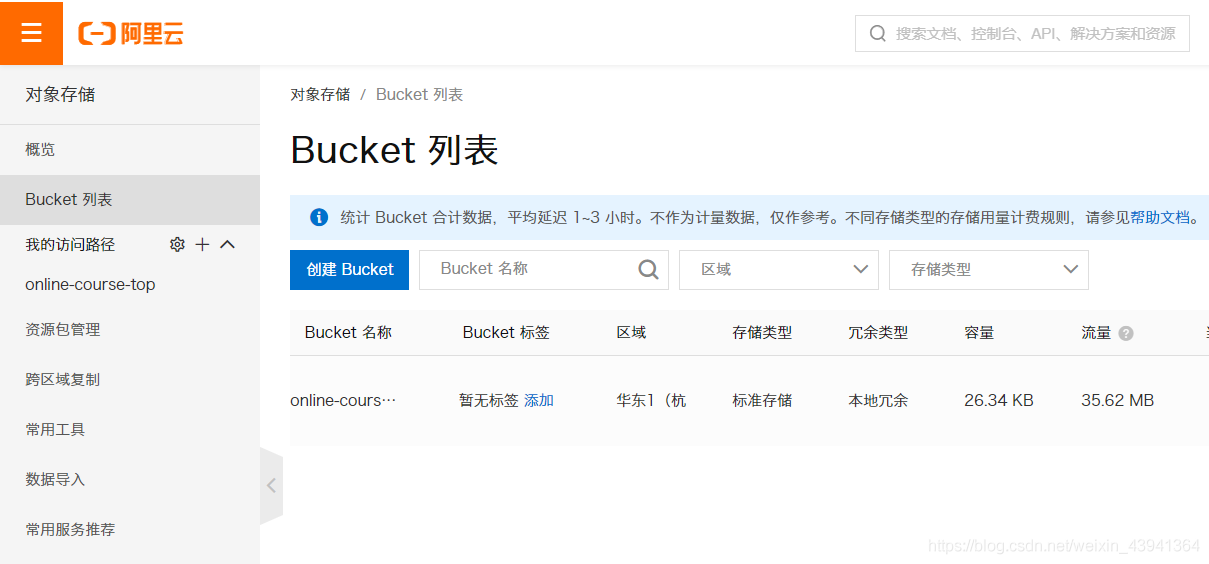
然后找到讀寫權限:

將讀寫權限設置為公共讀即可:

在 RAM 中新建一個用戶:
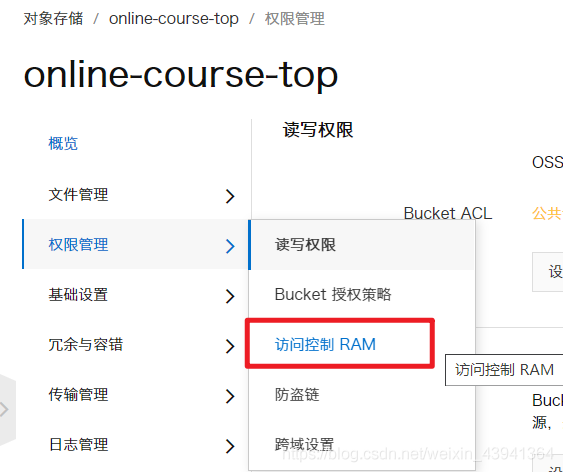
為其添加權限,選擇 OSS 的權限:
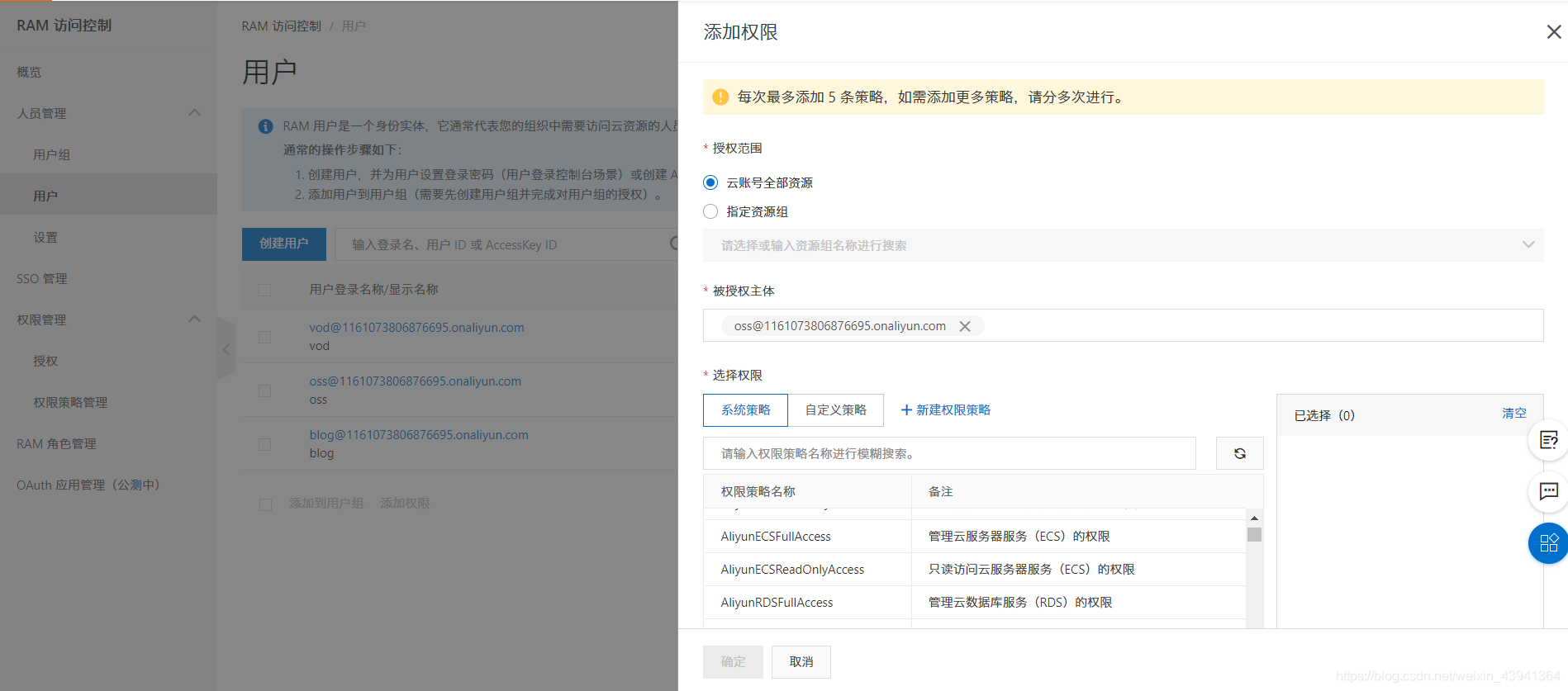
然后點進去這個用戶,找到 AccessKey:
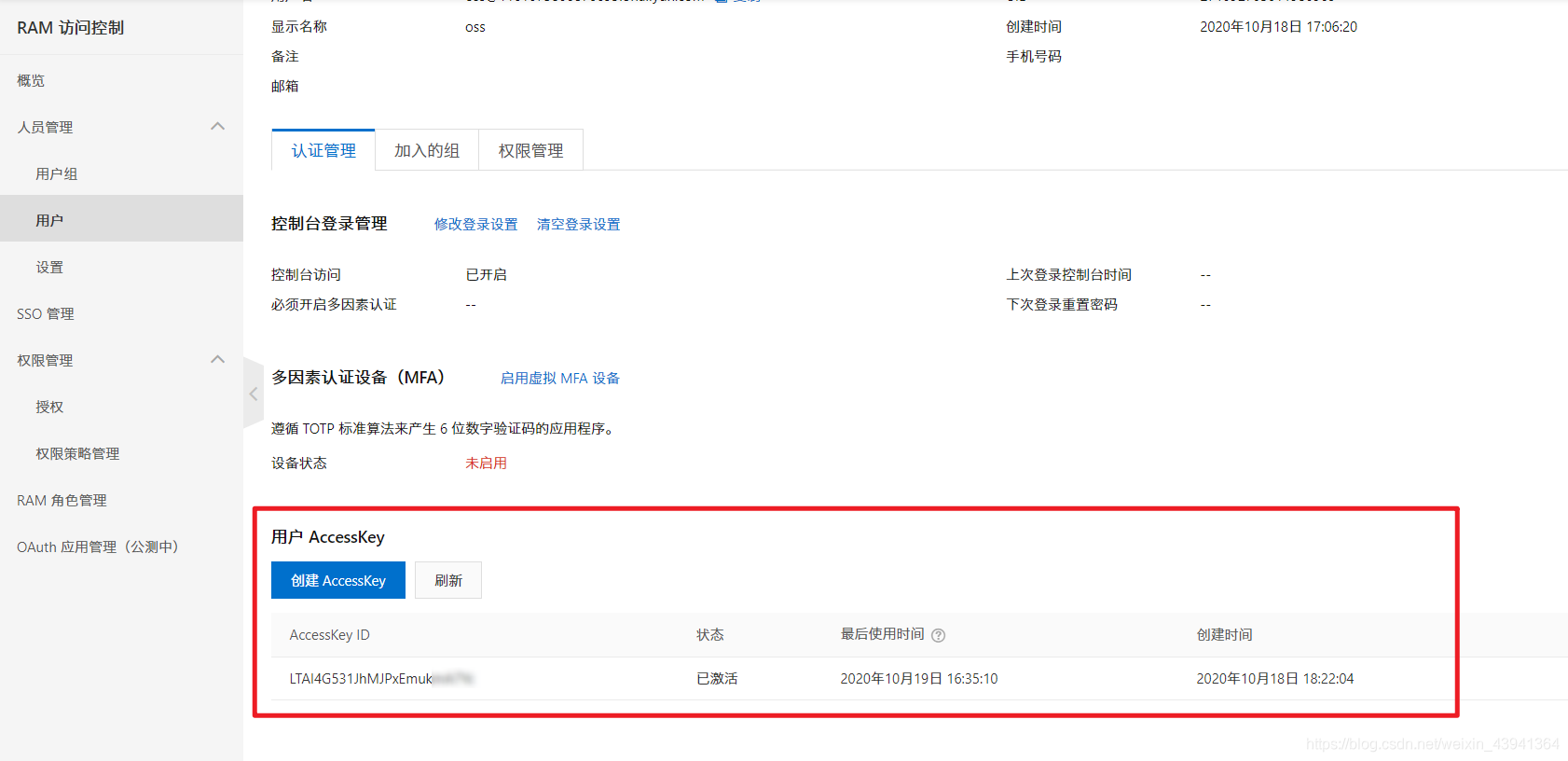
創建之后記下來 secret ,因為他只出現一次,如果沒記住也沒事,可以重新創建新的 key。
下面開始編寫服務端代碼:
POM
<!-- 阿里云oss --><dependency> <groupId>com.aliyun.oss</groupId> <artifactId>aliyun-sdk-oss</artifactId> <version>3.10.2</version></dependency>
package com.lsu.file.controller.admin;import com.alibaba.fastjson.JSONObject;import com.aliyun.oss.OSS;import com.aliyun.oss.OSSClientBuilder;import com.aliyun.oss.model.AppendObjectRequest;import com.aliyun.oss.model.AppendObjectResult;import com.aliyun.oss.model.ObjectMetadata;import com.aliyun.oss.model.PutObjectRequest;import com.lsu.server.dto.FileDto;import com.lsu.server.dto.ResponseDto;import com.lsu.server.enums.FileUseEnum;import com.lsu.server.service.FileService;import com.lsu.server.util.Base64ToMultipartFile;import com.lsu.server.util.UuidUtil;import org.slf4j.Logger;import org.slf4j.LoggerFactory;import org.springframework.beans.factory.annotation.Value;import org.springframework.web.bind.annotation.*;import org.springframework.web.multipart.MultipartFile;import javax.annotation.Resource;import java.io.ByteArrayInputStream;/** * @author wsuo */@RestController@RequestMapping('/admin')public class OssController { private static final Logger LOG = LoggerFactory.getLogger(FileController.class); @Value('${oss.accessKeyId}') private String accessKeyId; @Value('${oss.accessKeySecret}') private String accessKeySecret; @Value('${oss.endpoint}') private String endpoint; @Value('${oss.bucket}') private String bucket; @Value('${oss.domain}') private String ossDomain; public static final String BUSINESS_NAME = 'OSS文件上傳'; @Resource private FileService fileService; @PostMapping('/oss-append') public ResponseDto<FileDto> fileUpload(@RequestBody FileDto fileDto) throws Exception { LOG.info('上傳文件開始'); String use = fileDto.getUse(); String key = fileDto.getKey(); String suffix = fileDto.getSuffix(); Integer shardIndex = fileDto.getShardIndex(); Integer shardSize = fileDto.getShardSize(); String shardBase64 = fileDto.getShard(); MultipartFile shard = Base64ToMultipartFile.base64ToMultipart(shardBase64); FileUseEnum useEnum = FileUseEnum.getByCode(use); String dir = useEnum.name().toLowerCase(); String path = dir +'/' +key +'.' +suffix; // 創建OSSClient實例。 OSS ossClient = new OSSClientBuilder().build(endpoint, accessKeyId, accessKeySecret); ObjectMetadata meta = new ObjectMetadata(); // 指定上傳的內容類型。 meta.setContentType('text/plain'); // 通過AppendObjectRequest設置多個參數。 AppendObjectRequest appendObjectRequest = new AppendObjectRequest(bucket, path, new ByteArrayInputStream(shard.getBytes()), meta); appendObjectRequest.setPosition((long) ((shardIndex - 1) * shardSize)); AppendObjectResult appendObjectResult = ossClient.appendObject(appendObjectRequest); // 文件的64位CRC值。此值根據ECMA-182標準計算得出。 System.out.println(appendObjectResult.getObjectCRC()); System.out.println(JSONObject.toJSONString(appendObjectResult)); ossClient.shutdown(); LOG.info('保存文件記錄開始'); fileDto.setPath(path); fileService.save(fileDto); ResponseDto<FileDto> responseDto = new ResponseDto<>(); fileDto.setPath(ossDomain + path); responseDto.setContent(fileDto); return responseDto; } @PostMapping('/oss-simple') public ResponseDto<FileDto> fileUpload(@RequestParam MultipartFile file, String use) throws Exception { LOG.info('上傳文件開始'); FileUseEnum useEnum = FileUseEnum.getByCode(use); String key = UuidUtil.getShortUuid(); String fileName = file.getOriginalFilename(); String suffix = fileName.substring(fileName.lastIndexOf('.') + 1).toLowerCase(); String dir = useEnum.name().toLowerCase(); String path = dir + '/' + key + '.' + suffix; // 創建OSSClient實例。 OSS ossClient = new OSSClientBuilder().build(endpoint, accessKeyId, accessKeySecret); PutObjectRequest putObjectRequest = new PutObjectRequest(bucket, path, new ByteArrayInputStream(file.getBytes())); ossClient.putObject(putObjectRequest); ResponseDto<FileDto> responseDto = new ResponseDto<>(); FileDto fileDto = new FileDto(); fileDto.setPath(ossDomain + path); responseDto.setContent(fileDto); return responseDto; }}
這部分內容可以參考阿里云的幫助手冊:https://help.aliyun.com/document_detail/32011.html?spm=a2c4g.11174283.6.915.443b7da2mfhbKq
上面寫的是兩個接口:
追加上傳:/oss-append 簡單上傳:/oss-simple注意這里的參數都已經在 yml 文件中定義了:
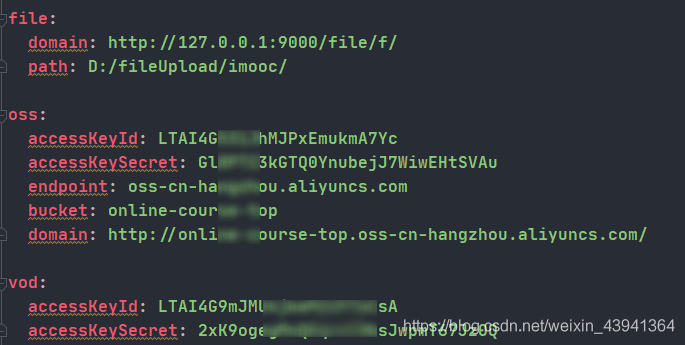
上面的 KeyId 和 KeySecret 就是之前在創建用戶時給的那兩個,填上就行了。
在前端我們就可以發送請求獲取數據,注意這里的對象是我自定義的,大家可以根據項目需求自行設置。
_this.$ajax.post(process.env.VUE_APP_SERVER + ’/file/admin/oss-simple’, formData).then(response => { Loading.hide(); let resp = response.data; _this.afterUpload(resp); // 清空原來控件中的值 $('#' + _this.inputId + '-input').val('');})
視頻點播
VOD 是另一種視頻存儲的形式,它的功能更豐。阿里云視頻點播(VOD)是集音視頻上傳、自動化轉碼處理、媒體資源管理、分發加速于一體的全鏈路音視頻點播服務。
我們同樣需要一個 VOD 的用戶,給它賦予 VOD 的權限:
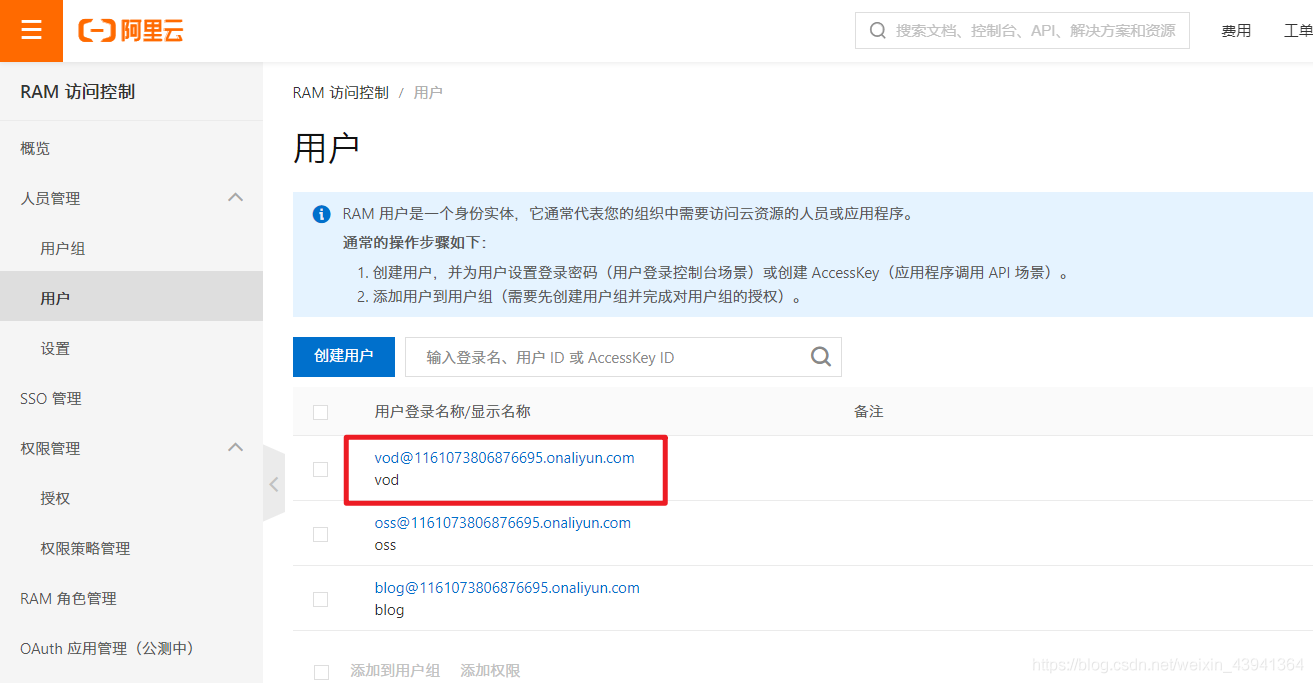
SDK 的使用可以參考文檔:https://help.aliyun.com/document_detail/61063.html?spm=a2c4g.11186623.6.921.418f192bTDCIJN
我們可以在轉碼組設置自己的模板,然后通過 ID 在代碼中使用:
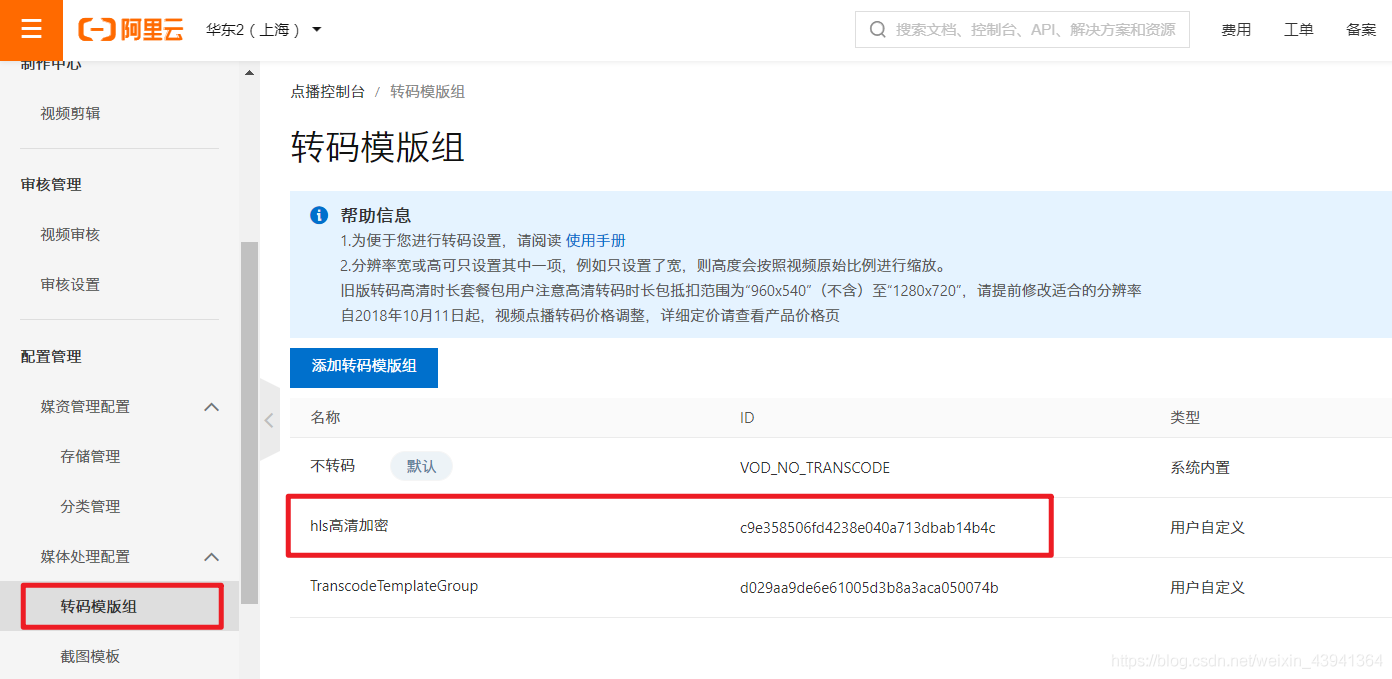
上傳視頻比較簡單,和 OSS 很像,但是播放視頻要多一個條件,在獲取播放鏈接之前要先取得權限認證,所以下面單獨寫了一個 /get-auth/{vod} 接口,其中的參數就是 vod 的 ID,這個 ID 在我們上傳視頻之后會作為返回值返回的。
package com.lsu.file.controller.admin;import com.alibaba.fastjson.JSON;import com.alibaba.fastjson.JSONObject;import com.aliyun.oss.OSSClient;import com.aliyuncs.DefaultAcsClient;import com.aliyuncs.vod.model.v20170321.CreateUploadVideoResponse;import com.aliyuncs.vod.model.v20170321.GetMezzanineInfoResponse;import com.aliyuncs.vod.model.v20170321.GetVideoPlayAuthResponse;import com.lsu.server.dto.FileDto;import com.lsu.server.dto.ResponseDto;import com.lsu.server.enums.FileUseEnum;import com.lsu.server.service.FileService;import com.lsu.server.util.Base64ToMultipartFile;import com.lsu.server.util.VodUtil;import org.apache.commons.codec.binary.Base64;import org.slf4j.Logger;import org.slf4j.LoggerFactory;import org.springframework.beans.factory.annotation.Value;import org.springframework.web.bind.annotation.*;import org.springframework.web.multipart.MultipartFile;import javax.annotation.Resource;/** * @author wsuo */@RestController@RequestMapping('/admin')public class VodController { private static final Logger LOG = LoggerFactory.getLogger(FileController.class); @Value('${vod.accessKeyId}') private String accessKeyId; @Value('${vod.accessKeySecret}') private String accessKeySecret; public static final String BUSINESS_NAME = 'VOD視頻上傳'; @Resource private FileService fileService; @PostMapping('/vod') public ResponseDto<FileDto> fileUpload(@RequestBody FileDto fileDto) throws Exception { String use = fileDto.getUse(); String key = fileDto.getKey(); String suffix = fileDto.getSuffix(); Integer shardIndex = fileDto.getShardIndex(); Integer shardSize = fileDto.getShardSize(); String shardBase64 = fileDto.getShard(); MultipartFile shard = Base64ToMultipartFile.base64ToMultipart(shardBase64); FileUseEnum useEnum = FileUseEnum.getByCode(use); String dir = useEnum.name().toLowerCase(); String path = dir +'/' +key +'.' +suffix; //需要上傳到VOD的本地視頻文件的完整路徑,需要包含文件擴展名 String vod = ''; String fileUrl = ''; try { // 初始化VOD客戶端并獲取上傳地址和憑證 DefaultAcsClient vodClient = VodUtil.initVodClient(accessKeyId, accessKeySecret); CreateUploadVideoResponse createUploadVideoResponse = VodUtil.createUploadVideo(vodClient, path); // 執行成功會返回VideoId、UploadAddress和UploadAuth vod = createUploadVideoResponse.getVideoId(); JSONObject uploadAuth = JSONObject.parseObject( Base64.decodeBase64(createUploadVideoResponse.getUploadAuth()), JSONObject.class); JSONObject uploadAddress = JSONObject.parseObject( Base64.decodeBase64(createUploadVideoResponse.getUploadAddress()), JSONObject.class); // 使用UploadAuth和UploadAddress初始化OSS客戶端 OSSClient ossClient = VodUtil.initOssClient(uploadAuth, uploadAddress); // 上傳文件,注意是同步上傳會阻塞等待,耗時與文件大小和網絡上行帶寬有關 if (shard != null) {VodUtil.uploadLocalFile(ossClient, uploadAddress, shard.getInputStream()); } System.out.println('上傳視頻成功, vod : ' + vod); GetMezzanineInfoResponse response = VodUtil.getMezzanineInfoResponse(vodClient, vod); System.out.println('獲取視頻信息 response = ' + JSON.toJSONString(response)); fileUrl = response.getMezzanine().getFileURL(); ossClient.shutdown(); } catch (Exception e) { System.out.println('上傳視頻失敗, ErrorMessage : ' + e.getLocalizedMessage()); } fileDto.setPath(path); fileDto.setVod(vod); fileService.save(fileDto); ResponseDto<FileDto> responseDto = new ResponseDto<>(); fileDto.setPath(fileUrl); responseDto.setContent(fileDto); return responseDto; } @RequestMapping(value = '/get-auth/{vod}', method = RequestMethod.GET) public ResponseDto<String> getAuth(@PathVariable String vod) { LOG.info('獲取播放授權開始'); ResponseDto<String> responseDto = new ResponseDto<>(); DefaultAcsClient client = VodUtil.initVodClient(accessKeyId, accessKeySecret); GetVideoPlayAuthResponse response; try { response = VodUtil.getVideoPlayAuthResponse(client, vod); String playAuth = response.getPlayAuth(); //播放憑證 LOG.info('授權碼 = {}', playAuth); responseDto.setContent(playAuth); //VideoMeta信息 LOG.info('VideoMeta信息 = {}', response.getVideoMeta().getTitle()); } catch (Exception e) { System.out.print('ErrorMessage = ' + e.getLocalizedMessage()); } LOG.info('獲取播放授權結束'); return responseDto; }}
methods: { playUrl(url) { let _this = this; console.log('開始播放:', url); // 如果已經有播放器了 就將播放器刪除 if (_this.aliPlayer) { _this.aliPlayer = null; $('#' + _this.playerId + ’-player’).remove(); } // 初始化播放器 $('#' + _this.playerId).append('<div id='' + _this.playerId + '-player'></div>'); _this.aliPlayer = new Aliplayer({ id: _this.playerId + ’-player’, width: ’100%’, autoplay: true, //支持播放地址播放,此播放優先級最高 source: url, cover: ’http://liveroom-img.oss-cn-qingdao.aliyuncs.com/logo.png’ }, function (player) { console.log('播放器創建好了') }) }, playVod(vod) { let _this = this; Loading.show(); _this.$ajax.get(process.env.VUE_APP_SERVER + ’/file/admin/get-auth/’ + vod).then((response) => { Loading.hide(); let resp = response.data; if (resp.success) { //如果已經有播放器了,則將播放器div刪除 if (_this.aliPlayer) { _this.aliPlayer = null; $('#' + _this.playerId + ’-player’).remove(); } // 初始化播放器 $('#' + _this.playerId).append('<div id='' + _this.playerId + '-player'></div>'); _this.aliPlayer = new Aliplayer({ id: _this.playerId + ’-player’, width: ’100%’, autoplay: false, vid: vod, playauth: resp.content, cover: ’http://liveroom-img.oss-cn-qingdao.aliyuncs.com/logo.png’, encryptType: 1, //當播放私有加密流時需要設置。 }, function (player) { console.log(’播放器創建好了。’) }); } else { Toast.warning(’播放錯誤。’) } }); }},
上述的前端代碼只是一個例子,playVod 調用的是阿里的播放器。
到此這篇關于SpringBoot+阿里云OSS實現在線視頻播放的示例的文章就介紹到這了,更多相關SpringBoot阿里云OSS在線視頻內容請搜索好吧啦網以前的文章或繼續瀏覽下面的相關文章希望大家以后多多支持好吧啦網!
相關文章:

 網公網安備
網公網安備